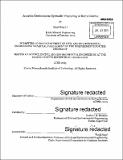| dc.contributor.advisor | Herbert H. Einstein. | en_US |
| dc.contributor.author | Li, Qiuyi Bing | en_US |
| dc.contributor.other | Massachusetts Institute of Technology. Department of Civil and Environmental Engineering. | en_US |
| dc.date.accessioned | 2015-10-30T18:57:34Z | |
| dc.date.available | 2015-10-30T18:57:34Z | |
| dc.date.copyright | 2015 | en_US |
| dc.date.issued | 2015 | en_US |
| dc.identifier.uri | http://hdl.handle.net/1721.1/99581 | |
| dc.description | Thesis: S.M., Massachusetts Institute of Technology, Department of Civil and Environmental Engineering, 2015. | en_US |
| dc.description | Cataloged from PDF version of thesis. | en_US |
| dc.description | Includes bibliographical references (pages 147-148). | en_US |
| dc.description.abstract | The purpose of this work is to observe acoustic emissions (AE) generated by laboratory scale hydraulic fracturing of Barre granite specimens with single or double flaw geometry. The scope of this work covers the experimental setup and subsequent analyses of these acoustic emissions, which in essence are elastic waves generated by displacements occurring within the rock specimen. Acoustic emissions can be analysed in a number of ways, whether individually or grouped together into events when a number of emissions arrive together. Individual emissions can be analysed for their amplitude, energy, or their frequency content while the source location and source mechanism can be inferred from events. The AE data are analysed in conjunction with water pressure, high resolution images, and high speed video taken during the experiment. Section 3 of this work outlines the selection and subsequent modification of the AE acquisition system with a specific focus on capturing AE at the end of each experiment in order to compare results to high speed video. This section describes the initial equipment selection, as well as initial experiments where it was noted that crucial data were missing around the time of the fracture event. This issue was largely resolved by modifying the system parameters as well as upgrading the PC supporting the AE acquisition cards. Section 4 of this work describes analysis of one experiment, providing an in-depth start-to-finish account of the nature of acoustic emissions at different phases of the experiment. This section also considers all of the hydraulic fracture experiments performed at different vertical loads and specimen flaw geometries, and draws some tentative conclusions regarding hydraulic fracturing in granite. | en_US |
| dc.description.statementofresponsibility | by Qiuyi Bing Li. | en_US |
| dc.format.extent | 205 pages | en_US |
| dc.language.iso | eng | en_US |
| dc.publisher | Massachusetts Institute of Technology | en_US |
| dc.rights | M.I.T. theses are protected by copyright. They may be viewed from this source for any purpose, but reproduction or distribution in any format is prohibited without written permission. See provided URL for inquiries about permission. | en_US |
| dc.rights.uri | http://dspace.mit.edu/handle/1721.1/7582 | en_US |
| dc.subject | Civil and Environmental Engineering. | en_US |
| dc.title | Acoustic emissions in hydraulic fracturing of Barre granite | en_US |
| dc.title.alternative | AE in hydraulic fracturing of Barre granite | en_US |
| dc.type | Thesis | en_US |
| dc.description.degree | S.M. | en_US |
| dc.contributor.department | Massachusetts Institute of Technology. Department of Civil and Environmental Engineering | |
| dc.identifier.oclc | 925472355 | en_US |
